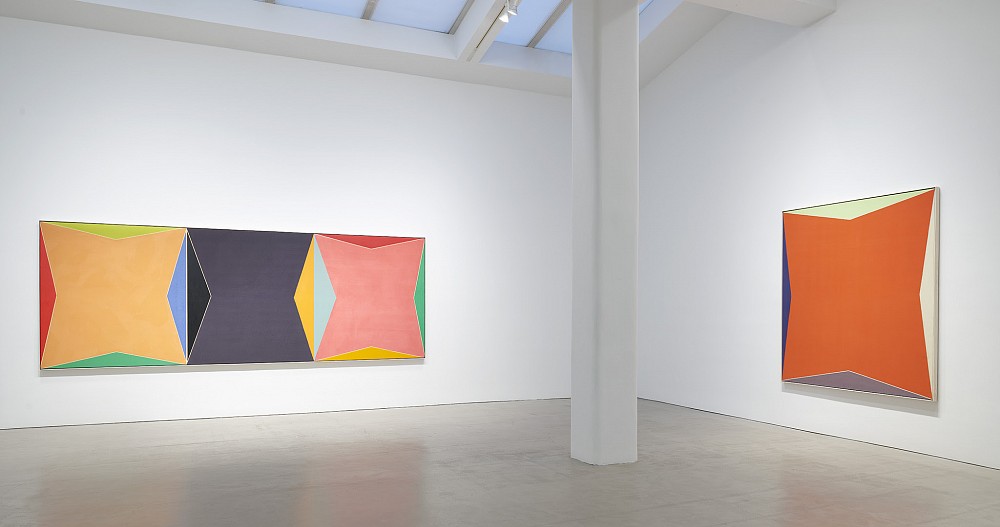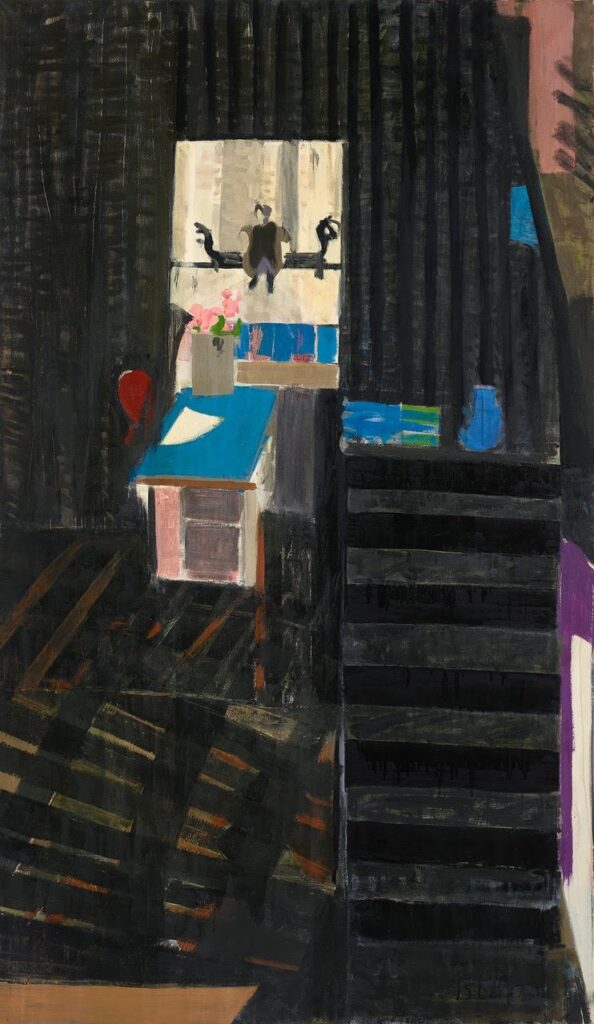
Installation View, Larry Zox: Gemini, Berry Campbell, New York, 2024.
Harmon Siegel for Artforum
March 2024
Why do some “Gemini” paintings succeed where others fail? As I study a given example from Larry Zox’s 1967–69 series of concave polygons, I feel that I know when one is working, but not necessarily why. It would satisfy no one to shrug, “I just like it,” or to cite some personal preference for a particular color combination. To apply standards enumerated in advance or derived from encounters with other artists’ work would also be misguided. Perhaps I should simply refrain from any qualitative judgments, disavow my initial instincts and restrict myself to neutral description. Yet their seriality invites––even demands––assessment, for it follows such tightly defined parameters that each canvas is directly comparable to the others. We are then left with the question: What criteria do the paintings themselves pose to help us evaluate them on their own terms?
Zox (1937–2006) named his series for its principal figure: his riff on the astrological sign. The eponymous shape is eight-sided and hard-edged, as though someone had pinched each side of a Bicycle playing card to form an obtuse angle. One so-called gemini molds four triangles in its negative space. Each composition thus comprises five figures with which the artist can try unique color combinations. As a whole, the series assays this configuration’s pictorial properties, testing its possibilities. In some of the earlier works on display, horizontal stripes cut across the central shape, while later ones distilled the artist’s project into a finite number of core variables.
The figure can be more or less symmetrical along one or both axes. Very slight unevenness among the four angles has an outsize effect on overall balance. Zox also played with contour, whether and how much to outline the edges. A slight white border amplifies figure/ground ambiguity between the gemini and the oblique triangles to each of its four sides. A thicker band does the opposite, thrusting the design off the surface, especially when bisected by a thin stroke of vibrant color. The acute angles that form the gemini’s points are usually congruent with the corners of the canvas, enhancing its graphicness. But when they seem to slip out of bounds or stop short of the edge, the whole surface becomes painterly. To that end, the artist varied his application, either embracing a housepainter’s uniformity or disavowing it via subtle gradations of opacity.
More dramatic effects come with color, number, and size. Zox claimed that he chose his hues randomly. Whether or not that is true, the juxtapositions usually feel well-calibrated to the gestalt. They can play a compensatory role, offsetting imbalances in geometric structure or perceived weight, as in Palanpup [sic], 1967, in which mauve and terra-cotta triangles seem to stop the airy, robin’s-egg Gemini from floating away. Or they can exaggerate the gestalt, as in one of the untitled works from 1969, where dusky surroundings intensify the void-like darkness of the center form. That year, Zox also experimented with repetition, placing double and triple Geminis laterally on horizontal canvases. Where their corners meet, the facing triangles form a diamond, amplifying figure/ground oscillation to the point of optical illusion. When the central motifs are all the same tone, the frame feels arbitrary, as though the pattern could continue ad infinitum. When the motifs are differently colored, the work enforces internal unity, dynamized by ineluctable imbalances.
While scale is relatively constant, the dimensions of Zox’s paintings can range from fifteen by fifteen inches to more than seven by seven feet. The difference prompts wildly disparate forms of bodily engagement. When more uneven design combines with points in the corners, the largest works evoke biomorphic forms. The points become tacks pinning the gemini in place, its span recalling the slaughtered oxen of Rembrandt or Chaim Soutine.
So why do some geminis work better than others? Because each is an experiment. As Zox modulated the series’ constitutive variables, he produced a series of singular results. Counterintuitively, the invariant parameters yielded unusual risk, for the success of each work teetered on the slightest adjustment to each element. The paintings thus gestated in a medium of uncertainty, resolved only when the last mark was made.
Read More >>




 Installation View of Lynne Drexler, The First Decade, 2022. Courtesy of the artist and Berry Campbell Gallery.
Installation View of Lynne Drexler, The First Decade, 2022. Courtesy of the artist and Berry Campbell Gallery.





